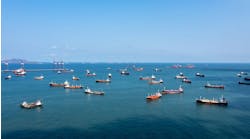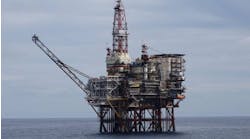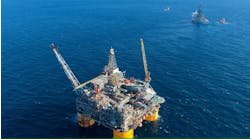Barents Sea yields third find
Hydro has found oil and gas in a barely explored sector of the Norwegian Barents Sea.
Nucula, drilled by the semisubmersiblePolar Pioneer in 293 m (961 ft) of water in production license 393, is around 110 km (68 mi) east-northeast of the Snøhvit and Goliat fields. Reports in Norway suggested the find could be bigger than Goliat, maybe up to 550 MMboe.
Hydro issued no reserve estimate, confirming only that the well had encountered hydrocarbons in two separate Triassic formations. There was no production test, and the well has since been plugged and abandoned.
As for Goliat, operator Eni, also a partner in Nucula, has been granted extra acreage within the surrounding production license 229 to help it determine the field’s extent. A development plan could follow next year. And on Snøhvit, the partners have reversed a recent decision not to appraise the oil zone underlying the field’s gas cap. However, any drilling will need to be concluded this summer, ahead of first gas production this December, and any subsequent oil development would have to be completed before serious gas pressure decline sets in. A joint scheme with Goliat is one of the options.
In the North Sea, the jackupWest Epsilon has proven fresh gas and condensate for Statoil in the Sleipner area. Well 16/4-4 on the Biotitt prospect found hydrocarbons within the Tertiary Heimdal formation. Statoil is considering a joint development with another find to the south, 16/7-2. And Talisman has boosted gas-condensate reserves at Rev (ex-Varg) in block 15/2, following a successful appraisal well, drilled by the Maersk Giant . Talisman aims to develop the field via a trans-median line subsea tieback to BG’s Armada platform.
Dong keen to exploit Hejre
Dong Energy looks set to acquire ConocoPhillips’ Danish sector business for $300 million. The package includes equity in three North Sea licenses containing numerous discoveries, with further exploration potential.
The main asset appars to be Hejre, a high-pressure/high-temperature oil field in license 5/98, in the northern part of the Danish Central Graben. According to London-based analysts ScanBoss, the four Hejre partners, which included Dong, already were close to submitting a development plan, with a view to start-up in 2009/10. This involved a wellhead platform tied back 20 km (12.5 mi) to a new processing installation at Hess’ Arne South complex.
Assuming approval for the transaction from the Danish Energy Authority, Dong and its partners will pursue development. Other prospects under review include the 2002 gas-condensate find Svane 30 km (19 mi) east of Hejre. Last year, ConocoPhillips also found hydrocarbons in the Stork prospect in the same area, on license 4/98, although the well was plugged and abandoned.
Norway’s reserves hold steady
Recoverable reserves throughout the Norwegian shelf totalled around 13 bcm (459 bcf) oil equivalents at the end of last year. According to the Norwegian Petroleum Directorate (NPD), this estimate represents a small drop on the previous year’s figure.
NPD identified six new discoveries during 2006, adding probable new reserves of 21 MMcm (742 MMcf) of oil and 10 bcm (353 bcf) of gas. This is a lower yield than in 2005, it adds, although evaluation of these finds is ongoing. At the end of last year, NPD listed eight fields under development, all due to enter production during 2007, aside from Tyrihans.
That list did not include two major BP-operated projects, Skarv-Idun in the Norwegian Sea, and Valhall Re-Development in the North Sea, close to the median line with Denmark. BP recently contracted Samsung for the $400 million, 40,600-metric-ton (44,754-ton) hull for Skarv-Idun’s FPSO. Assuming government sanction for the 470 MMboe development, this should be delivered in January 2010.
The Valhall program involves replacing existing installations with a single living quarters/process platform. BP was due to submit the development plan by end-March, but has already lined up Heerema Zwijndrecht for the 11,000-metric-ton (12,125-ton) deck and 318-metric-ton (350-ton) flare boom, and Aker Kvaerner Verdal for the 10,433-metric ton (11,500-ton) jacket and piles.
UK/Ireland gas hunt gathers pace
Tumbling gas prices on the UK mainland have not deterred activity offshore. Among those pursuing new opportunities are ATP, which last month was set to spud a dual-purpose horizontal well from its new Wenlock platform in southern North Sea block 49/12b. After intersecting a Rotliegend sandstone column for development purposes, it was due to probe an adjacent upthrown fault block. If successful, the well will be completed immediately and placed on production. ATP also is putting in two more wells to lift output at its nearby Tors development.
Close to the V-fields off the Norfolk coast, Silverstone Energy and partners ConocoPhillips and BP found a 95-m (311-ft) gas column with well 49/17-14, pushing estimated reserves in and around the LxB North field to over 120 bcf. In the Central North Sea, Dana Petroleum and its partners in the Barbara field are considering a joint development with the neighboring Phyllis discovery. This could emerge as one of the UK’s largest new gas projects.
Offshore southern Ireland, thePetrolia is drilling two wells for Island Oil and Gas that could lead to two new satellite tiebacks to Marathon’s Kinsale production complex.





